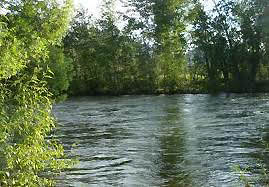
The erosion began in 1984 when the court held that rivers or streams capable of recreation could be used by the public, regardless of whether they are navigable and regardless of who owns the streambed on which the public walks.
With landowners outraged by the ruling, the legislature tried to slow the erosion of property rights in 1985 by passing the “Stream Access Law.” The law limits recreation to activities such as fishing, hunting, swimming and floating and limits access to areas between the high water marks, specifically excluding irrigation ditches. It also limits access across posted private property to gain access. The legislature provided further sideboards regarding access at bridges, saying, “absent definition in an easement or deed to the contrary, the width of a bridge right-of-way is the same width as the right-of-way of the road to which the bridge is attached.” In other words, stay on the bridge unless the government owns the land around it.
Who would have thought that the Montana Supreme Court would do end-runs around the legislature’s intent? Answer: public access groups such as the Bitterroot River Protective Association (BRPA) and the Public Lands Access Association (PLAA). They ignore the distinction between private and public land, and use litigation to take private land without compensation.
Such a taking occurred in 2008 when the BRPA convinced the Montana Supreme Court that a ditch, hand dug by pioneers in the 1860s, was a natural stream and therefore open to public access. Pressure to open access came mainly because landowners along the ditch spent millions of private dollars to create trout habitat. The Supreme Court deemed the ditch a natural waterway, reversing the district court and county conservation district finding of fact that the Mitchell is a ditch.
Now with access allowed for wading, public access advocates want to expand use to include floating, despite the fact that the ditch is so narrow you can jump across it in several places. They want access points for launching their water craft, and they want landowners to raise or remove private bridges that might obstruct floating. In short, they want it all, and they want someone else to pay for it.
The most recent judicial erosion of property rights came this month when the Montana Supreme Court opened the floodgates for access at every country road bridge in the state. PLAA began the litigation by suing the Madison County Commissioners when they allowed a private landowner to fence up to the bridge at Seyler Lane, which crosses the Ruby River.
The lawsuit claimed that a prescriptive easement, established for transportation, went beyond the roadway to include a much wider swath of private land and went beyond transportation and bridge maintenance to include recreation. When asked whether the PLAA’s claim that the public could leave the paved right-of-way and cross private land to enter the Ruby River, then Attorney General Joe Mazurek concluded that the public only has an easement to the precise path that it could show was used “openly, continuously, adversely and notoriously” for five years.
Although there is no such path to the river at Seyler Lane, PLAA argued that any land needed to support a paved road or maintain the bridge could be taken from the landowner and used for access. The district court ruled against PLAA, finding that the public right-of-way was only for the paved road
Not surprisingly, PLAA appealed to its friendly activists on the Montana Supreme Court. They reversed the lower court and expanded the easement saying it includes “any foreseeable uses of the public road right-of-way, including recreation use.” Justice Laurie McKinnon recognized the implications of the ruling in her dissent, saying “the court’s opinion disregards more than a century of precedent governing prescriptive easements and undermines the balance the Legislature has struck between landowners and recreationists.” So much for balance!
Both the Mitchell Slough and the Ruby River are examples of private conservation in the public interest. But the continual erosion of property rights is cutting off the public benefits that flow from these private lands. Isn’t it time to say enough is enough?
Related articles:
PERC’s Amicus Brief for Public Lands v. Madison Co. Commission – Terry Anderson and Reed Watson
PERC’s Stream Access Position Statement – Terry Anderson and Reed Watson
Property Rights Are for Everyone – Terry Anderson, Billings Gazette
Stream Access Across the West – Reed Watson, PERC Reports



